�
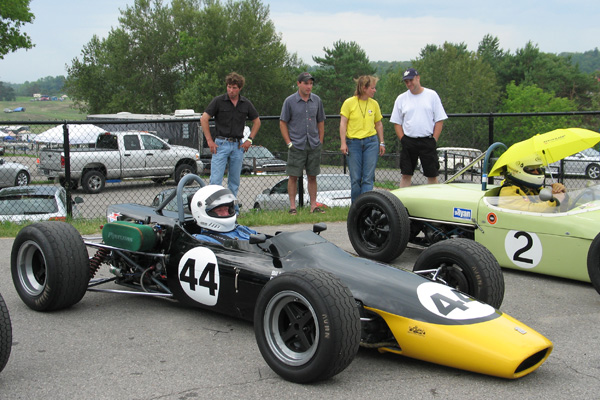
�
Bill Bovenizer's 1968 Titan MkIII Formula B Racecar
� ��
Owner: Bill Bovenizer
�
City: Ajax, Ontario
�
Model: 1968 Titan MkIII
�
Engine: Ford-Lotus twin-cam 1.6L
�
Prepared by: Britain West Motorsport, Brantford Ontario�
�
Charles Lucas Engineering Ltd. and their Titan Racecars
��
In 1965, Charles Lucas received an inheritance and decided to invest it in motor racing.�
Lucas joined with Roy Thomas to form Charles Lucas Engineering Limited. CLE started as�
a race team by purchasing the three used Brabham BT10 racecars Jack Brahbam, Denny Hulme,�
and Graham Hill had campaigned throughout the 1964 Formula Two season. It was Roy Thomas' job�
to rework these cars to the one year old one-liter Formula 3 specifications. Charles Lucas,�
Jonathan Williams, and Piers Courage would drive. The ambitious young CLE team dominated�
1965 European F3 racing to such an extent that Colin Chapman hired them to represent�
Lotus through the 1966 Formula Three season.�
�
Lotus and their sponsors selected Piers Courage and American driver Roy Pike who had won�
the 1965 BARC (British) Formula Three championship to pilot the "Charles Lucas Team Lotus"�
Formula Three cars. The team's brief was to break Brabham's domination as a Formula Three�
constructor, using Lotus' new type 41 racecar. (With the 41, Lotus Components reverted�
to a spaceframe chassis.) Though not all-conquering, perserverance paid off and Piers Courage�
finished the 1966 European season second only to Chris Irwin of the Chequered Flag Team who�
drove a Brabham BT18. However, for reasons of his own Colin Chapman decided to keep the�
team's Firestone appearance money to himself. The inequity drove CLE to terminate their�
association with Lotus and to develop their own car for 1967. �
�
�
 �
�
�
�
� Charles Lucas and Roy Thomas named their new Formula 3 model the "Titan Mk3" and� planned its debut for the Formula Three support race at the 1967 British Grand Prix� (Silverstone, July 15). Things went well, but not exactly to plan. Driving the Mk3,� Roy Pike qualified for poll position. Driving a leftover Lotus 41 upgraded with a� CLE-built prototype Ford-Cosworth MAE engine with a downdraft induction system� Charles Lucas qualified third. However, a spinout by Lucas removed Pike and his� Titan from contention. Lucas recovered for an impressive come-from-behind victory.� The result was that CLE received over 100 engine orders by the end of the following day!� So it happened that a small racing team became both a car constructor and an engine� builder of note on the strength of one successful race.�
�Bill Bovenizer's Titan Mk3: car 68/306, frame AM-4
��
Titan Mk3 number 68/306 was originally raced in England by Charles Sawyer-Hoare as a�
one-liter Formula Three car. It was powered by a Ford 109E based "MAE" engine�
(Charles Lucas Engineering serial number 68/019) which probably produced approximately�
110-118bhp at 9500rpm. Mr Sawyer-Hoare is known to have entered eighteen events in 1968.�
Of race we results we've found, his best was an impressive victory in the Bristol Trophy�
race at Castle Combe on April 13, 1968. That's the only podium finish we found for�
Sawyer-Hoare in 1968; he tied for 31st place in the 1968 BRSCC Formula Three championship.�
�
�
68/306 was purchased by Tommy Bunn on behalf of Fred Roehr of Portland Oregon. (As a�
USAF pilot stationed in Germany, Bunn had raced a Lola Mk5 in Formula Junior and�
Formula Three events in Europe. After returning to the U.S., Bunn drove his Lola�
in SCCA Formula C races.) Fred Roehr was an American driver who raced the Titan�
quite successfully in the Pacific Northwest. Roehr placed fifth in the Formula C class�
and eleventh overall (of 12 and 22 respectively) in the 1969 American Road Race of�
Champions at Daytona, which doubled as the SCCA championship in those years. Roehr�
returned and entered 68/306 in both the 1970 and 1971 ARRC events, but failed to�
finish those two times.�
�
�
After a major engine failure, 68/306 was purchased by Don Starr who removed the Ford�
engine and installed a Kawasaki motorcycle engine complete with integral transmission�
and chain drive. The car then passed through several owners before being discovered�
by Bob Erickson and Don Snyder who saw its potential for restoration.�
�
We believe Erickson and Snyder converted 68/306 to Formula B specification, complete�
with Lotus Twin-Cam engine. This specification put the car a more popular race group�
and very likely reduced operating costs too. (The usual reasoning is that the Twin-Cam�
engine is less highly tuned than a competitive MAE engine, and thus lasts longer�
between rebuilds or breakdowns.)�
�
Brad and Dean Baker of Ontario were the Titan's next owners. The Baker brothers raced�
68/306 in Ontario over a period of about ten years. Bill Bovenizer purchased this Titan�
from Dean Baker in February 2004 and has enthusiastically campaigned it ever since.�
Please support the sponsoring companies who make www.BritishRaceCar.com possible, including:
� �
 �
�
�
�
Features and Specifications (as photographed)
�| Engine: | �Lotus-Ford twin-cam 1.6L engine (~175hp).�
Dual Weber 45DCOE carburetors.�
Pipercross foam air cleaner.�
Lucas distributor.�
Lucas AB14 electronic ignition amplifier.�
Lucas ignition coil.�
Taylor Pro 8mm silicone spark plug wires.�
Dry sump lubrication system.�
Mocal 10-row aluminum oil cooler. | �
| Cooling: | �custom copper and brass crossflow radiator from Brown Radiator Shop. | �
| Exhaust: | �custom stainless steel four-into-one headers. | �
| Transaxle: | �Hewland Mk8 five speed.�
Rotoflex drive couplings.�
Lockheed master cylinder.�
Girling slave cylinder. | �
| Front Susp.: | �unequal length wishbones.�
Alford & Alder (Triumph Herald pattern) forged uprights.�
KONI double-adjustable coilover shock absorbers.�
Adjustable anti-sway bar.�
Titan proprietary steering rack. | �
| Rear Susp.: | �inverted lower wishbones, single top links, and twin radius arms.�
Titan proprietary magnesium uprights.�
KONI double-adjustable coilover shock absorbers.�
Adjustable anti-sway bar. | �
| Brakes: | �(master) Lockheed master cylinders with adjustable bias bar. AP551 brake fluid. � (front) AP Lockheed magnesium calipers. Solid rotors. � (rear) AP Lockheed magnesium calipers. Solid rotors. | �
| Wheels/Tires: | �Brabham style 4-spoke magnesium wheels.�
Avon tires (8.2/22.0/13 front and 10.5/23.0/13 rear). | �
| Electrical: | �Odyssey battery.�
Tilton Super Starter XLT starter. | �
| Instruments: | �(left to right)�
Smiths coolant temperature gauge (0-230F),�
Smiths Chronometric tachometer (0-12000rpm), and�
Smiths oil pressure gauge (0-100psi). | �
| Fuel System: | �ATL five gallon wedge-shaped under-seat fuel cell.�
Facet (Bendix type) electric fuel pump.�
Adjustable fuel pressure regulator. | �
| Safety Eqmt: | �Willans six point cam-lock safety harness.�
Lifeline quick release hub on a Momo ergonomic steering wheel.�
SPA Design FireFighter centralized fire supression system.�
LED rain light. | �
| Racing Class: | �originally built for Formula Three, but currently configured for Formula B. | �
Engine Installation
��
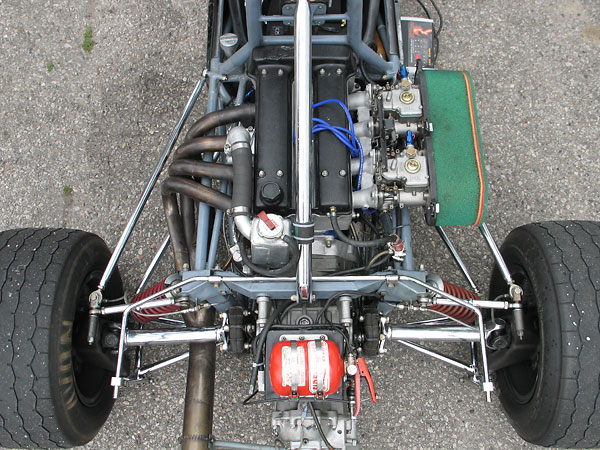
�
Lotus-Ford twin-cam 1.6L engine.
�
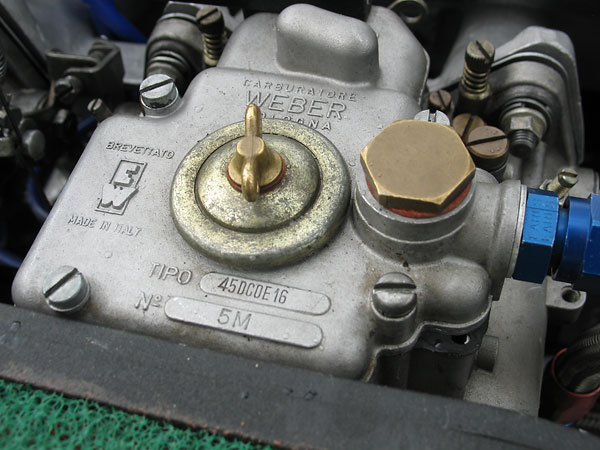
�
Weber Carburatore Bologna: Tipo 45DCOE16, Number 5M.
�
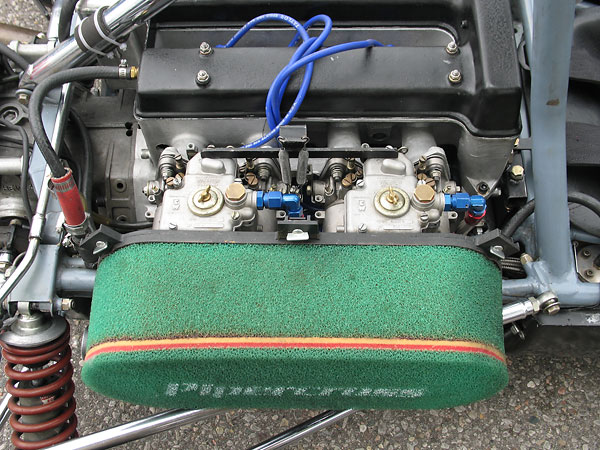
�
Pipercross foam air cleaner.
�
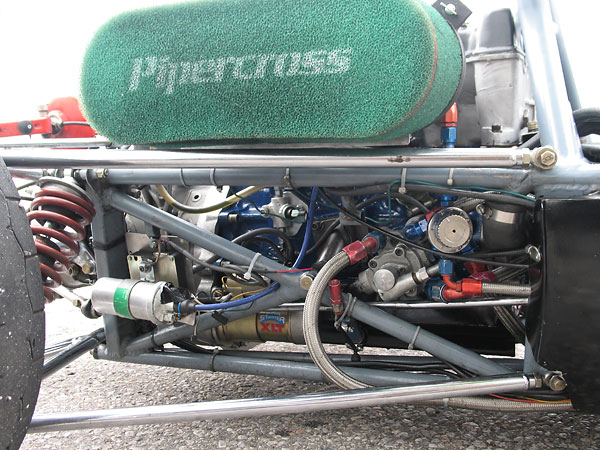
�
At left: Lucas AB14 electronic ignition amplifier and Lucas ignition coil. The Titan Mk3 was
�
originally equipped with a Lucus Opus ignition amplifier, but they're notoriously unreliable
�
and service parts for them are no longer available.
�
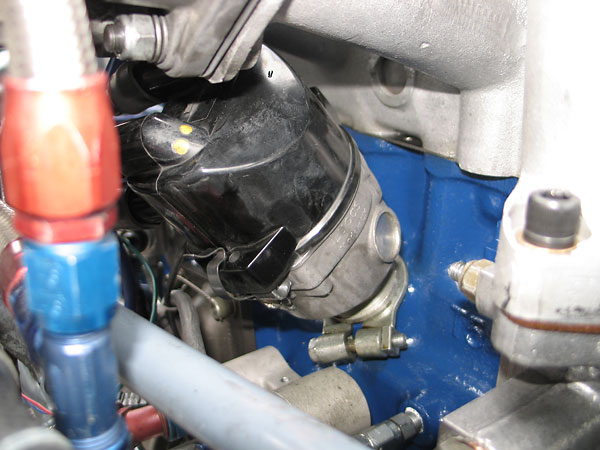
�
Lucas distributor.
�
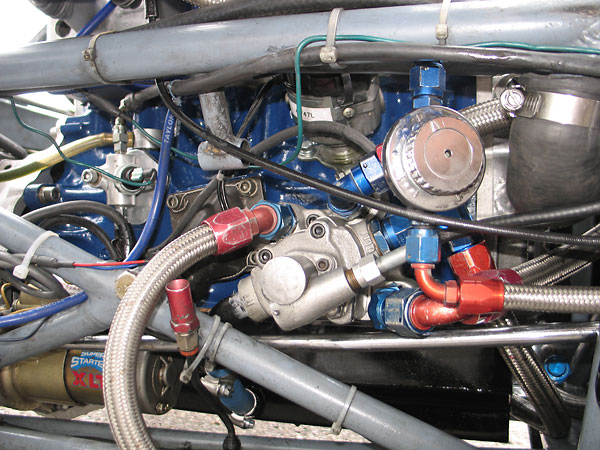
�
Tachometer drive on the end of the oil pump. At right: dial type fuel pressure regulator.
�
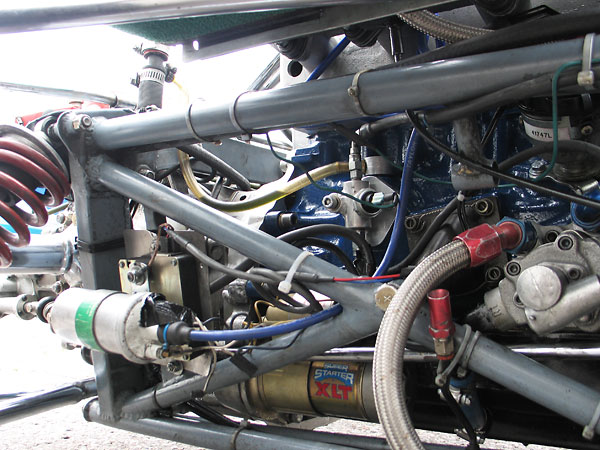
�
The original Lucas starter was judged unreliable, so a Tilton Super Starter XLT was substituted.
�
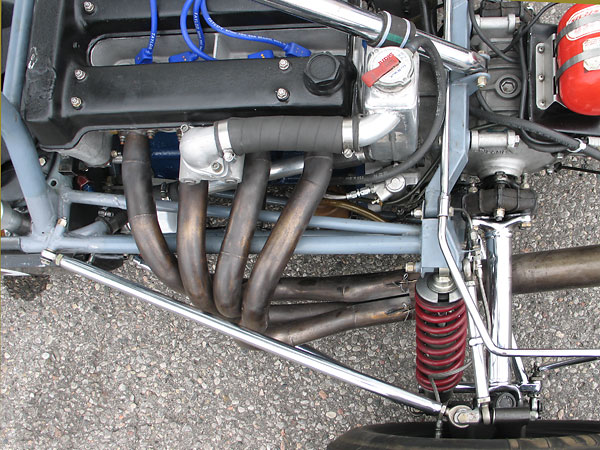
�
Handsomely crafted custom fabricated stainless steel four-into-one headers.
�
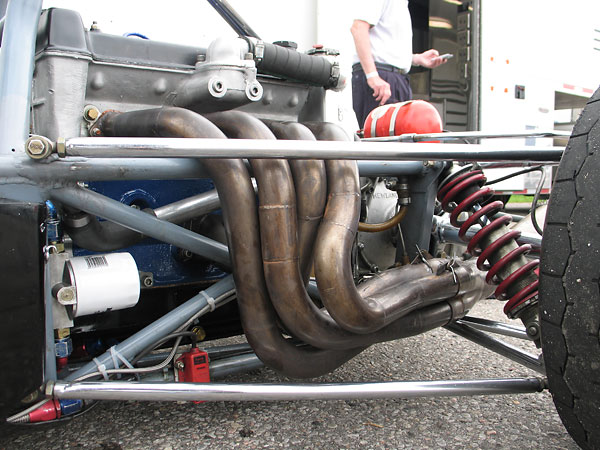
�
The shape and routing of the header tubes appear to accurately replicate CLE's original routing.
�
(Of course the original headers mounted to a differently dimensioned cylinder head.)
�
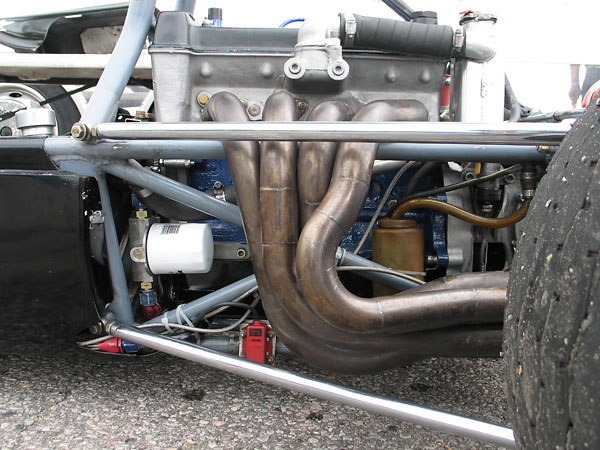
�
The original headers would almost certainly have been sand-bent out of mild steel tubing.
�
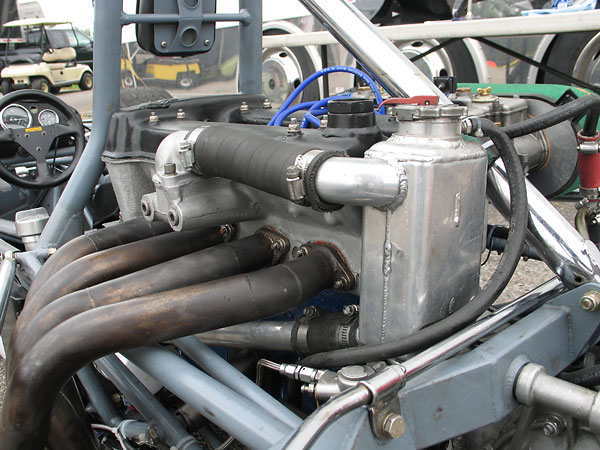
�
Fabricated aluminum coolant header tank.
�
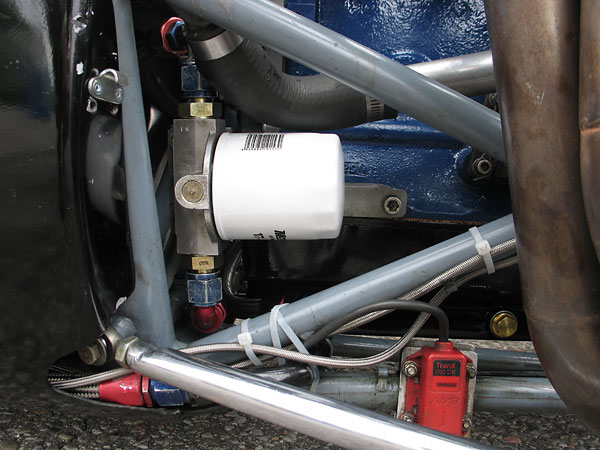
�
Oil filter.
�
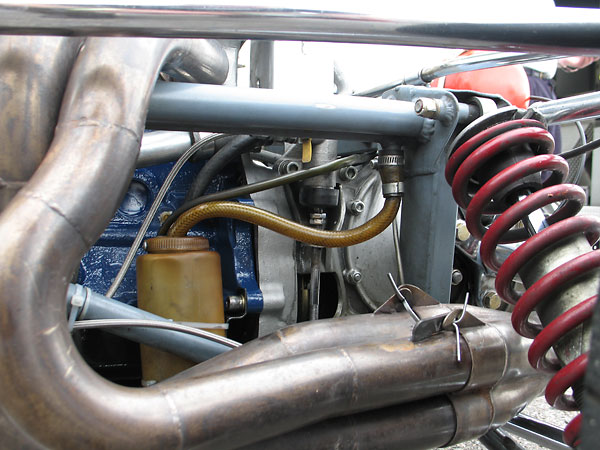
�
Crankcase breather feeds through frame and comes out at overflow bottle here.
�
Background: Girling clutch slave cylinder.
�
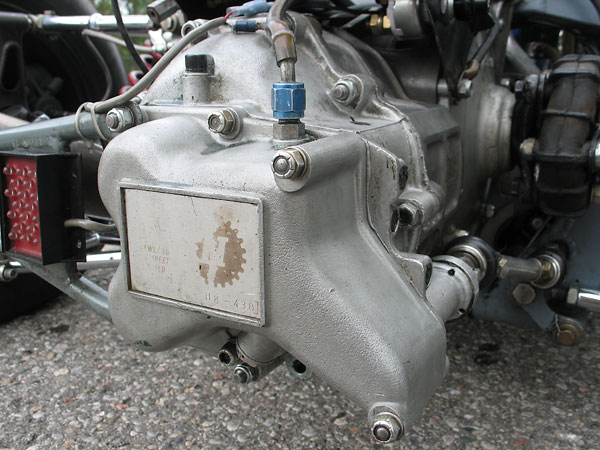
�
Hewland transaxle, marked "H8-438". Hewland's Mk8 & Mk9 transaxles are variants of a common design.
�
The Mk8 5-speed is popular with Formula 3 & B racers. The Mk9 4-speed meets Formula Ford class rules.
�
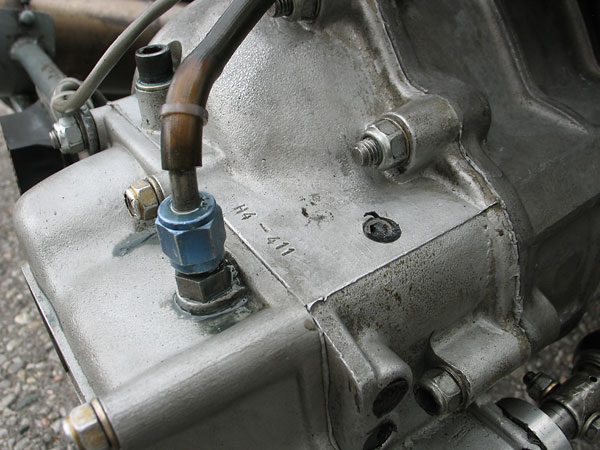
�
Hewland transaxle, marked "H4-411".
�
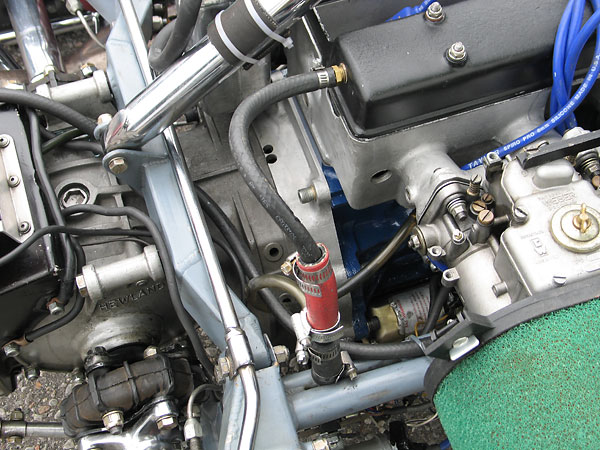
�
The engine's valve cover is vented through a chassis tube forward to the oil reservoir.
�
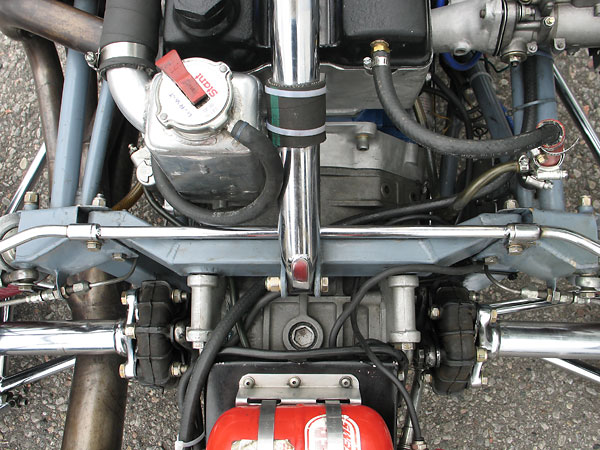
�
Elaborately fabricated rear crossmember. (The roll hoop brace is a later addition.)
�
�
Front Suspension / Etc.
��
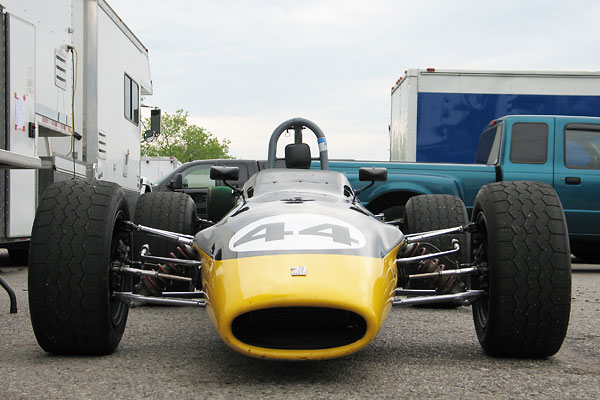
�
Unequal length, unparallel, dual wishbone independent front suspension.
�
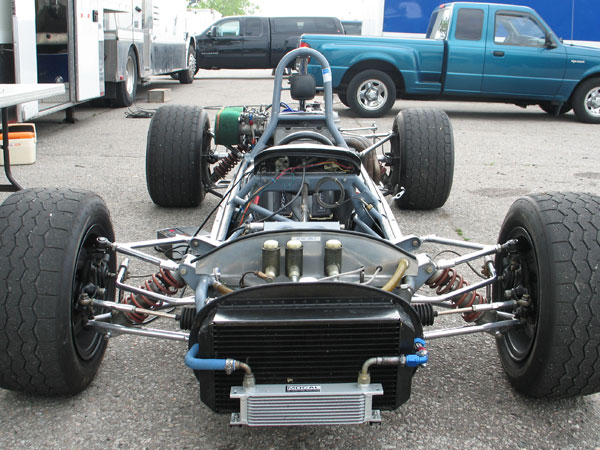
�
Monoposto Racing's rules for Formula B and Formula Two vintage racecars are very specific
�
with regard to tire selection. In a nutshell, made-for-racing treaded tires are required.
�
Tire diameter, width, aspect ratio, tread pattern and tread depth are all restricted.
�
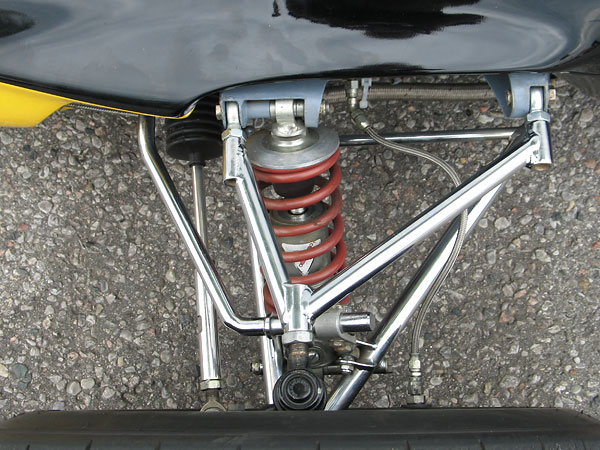
�
KONI double-adjustable coilover shock absorbers.
�
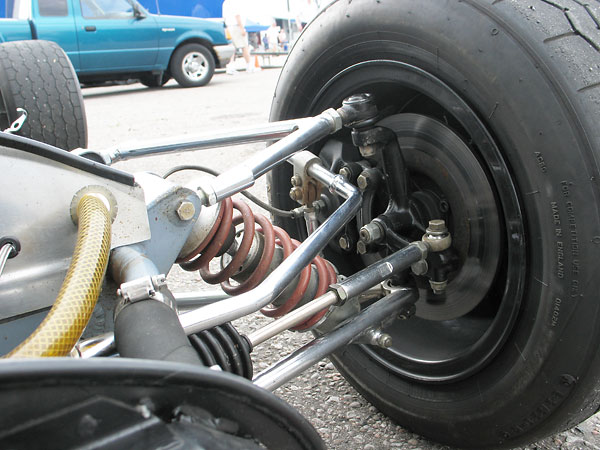
�
Alford & Alder (Triumph Herald pattern) forged uprights.
�
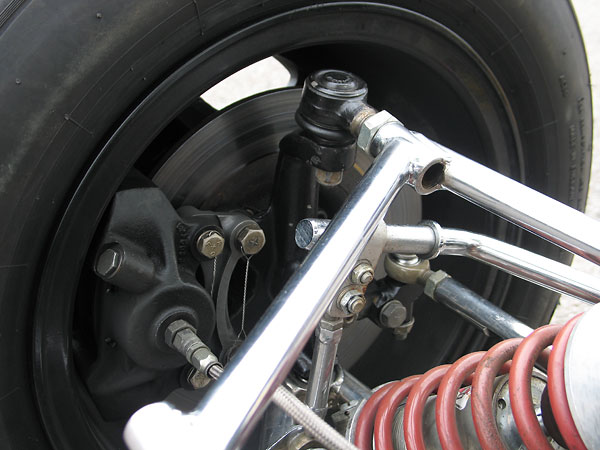
�
Titan Mk3 racecars were fitted with Lockheed magnesium brake calipers, both front and rear.
�
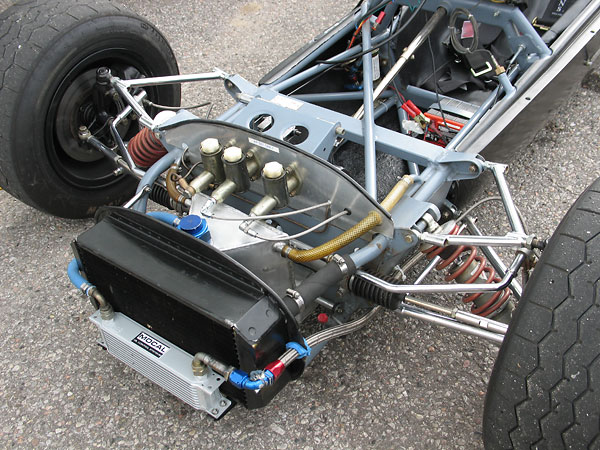
�
The Titan Mk3 model came with Lockheed steel master cylinders for both brake and clutch.
�
(Later Titan models and nearly all other purpose-built British racecars of the era used Girlings.)
�
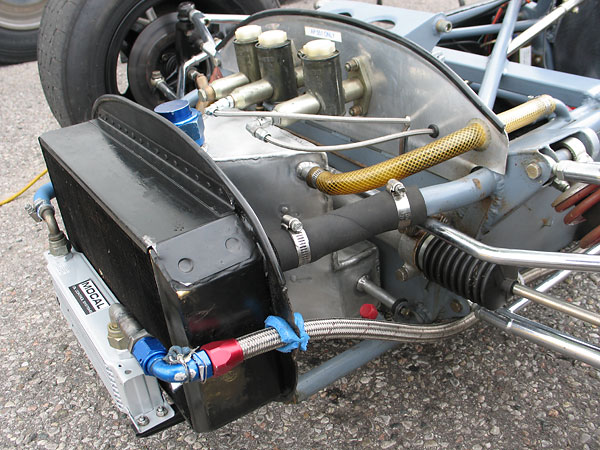
�
The car's original radiator had a built-in oil cooler. This Mocal 10-row aluminum oil cooler is a
�
more practical alternative because it's inexpensive to replace. Trying to clean an oil cooler
�
after an engine failure such as a "spun" bearing is a fool's errand.
�
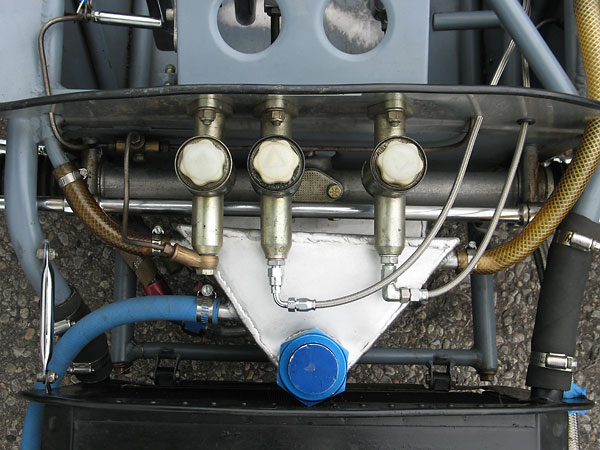
�
Custom fabricated aluminum engine oil reservoir.
�
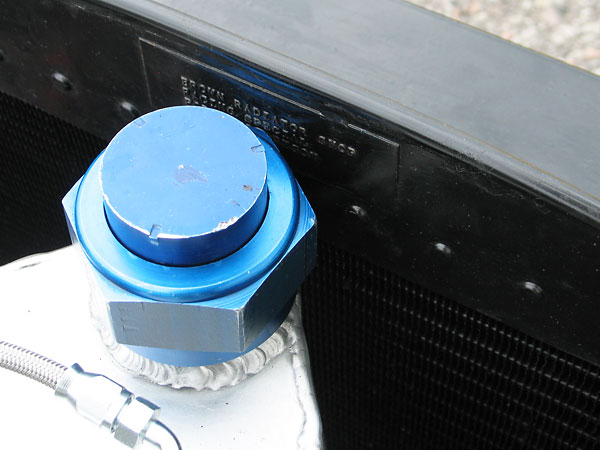
�
Brown Radiator Shop - Racing Special - Portland Oregon
�
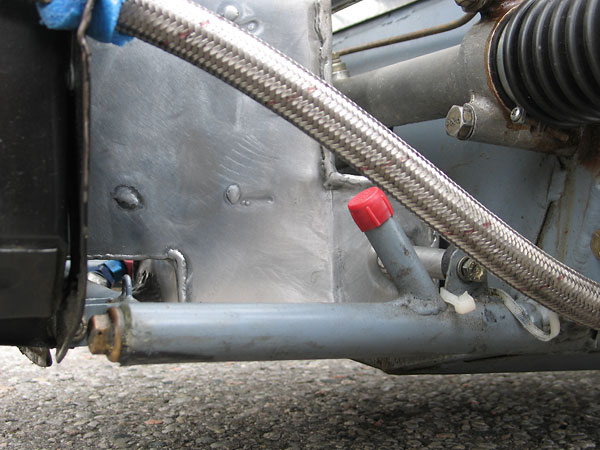
�
Titan originally routed engine oil to the oil cooler through the lower longitudinal frame tubes.
�
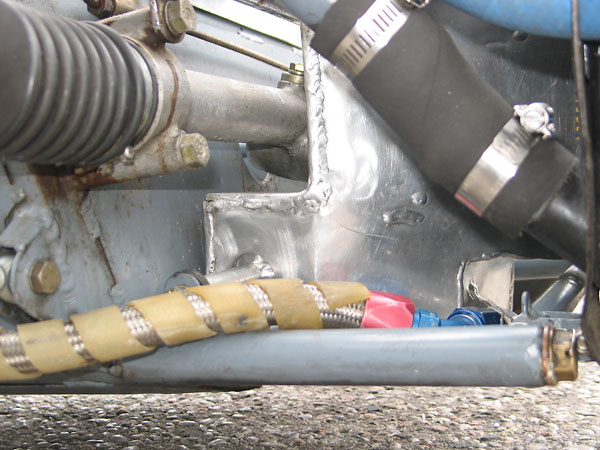
�
These oil carrying tubes have now been blocked off, in lieu of externally routed oil lines.
�
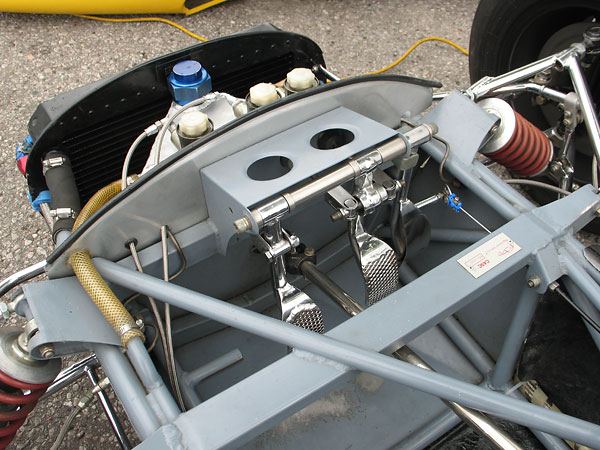
�
However, other frame tubes are still used for venting the oil reservoir to a breather/overflow tank.
�
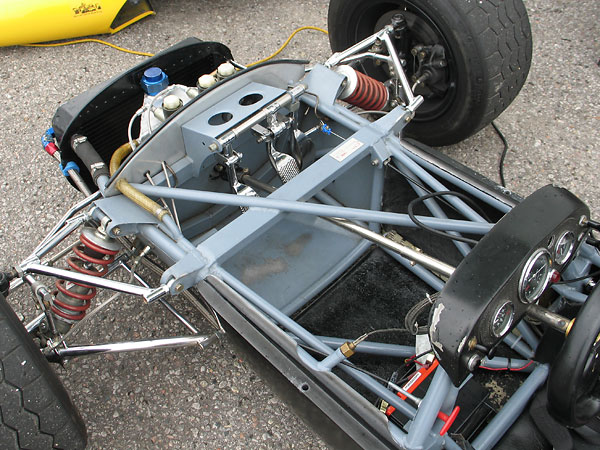
�
The two larger diameter, upper frame tubes carry engine coolant.
�
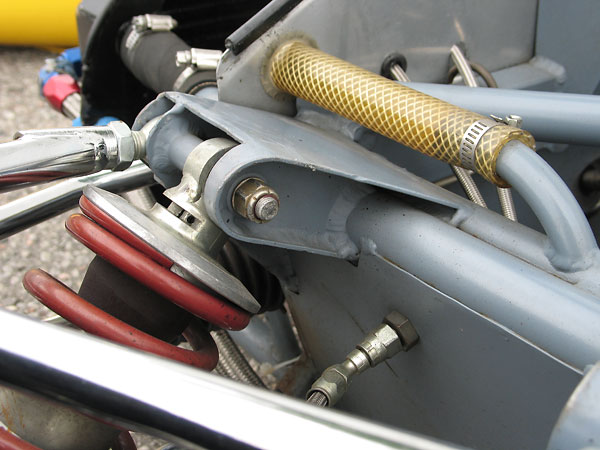
�
Rebound adjuster at the top of the shock absorber.
�
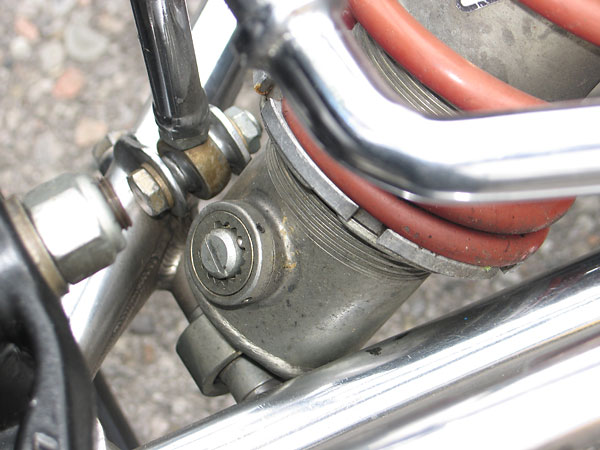
�
Compression adjuster at the bottom of the shock absorber.
�
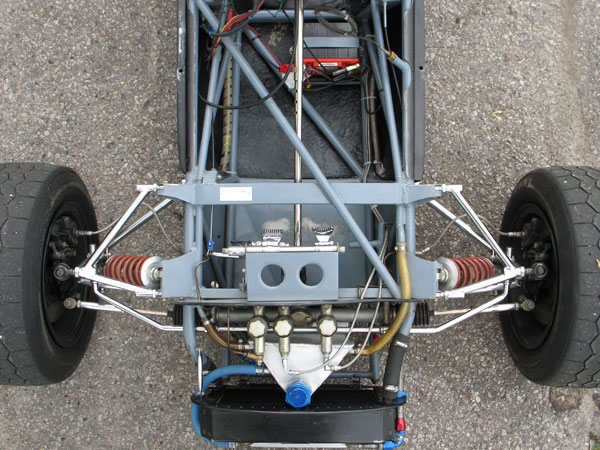
�
In many ways the Titan chassis bears a strong resemblance to Brabham designs which preceded it.
�
If it wasn't exactly innovative, the Titan was at least a very well constructed derivative.
�
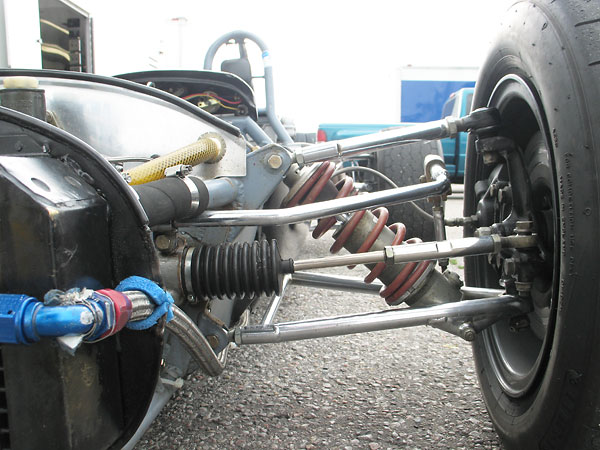
�
Titan made their own steering racks, and in later years provided racks to other constructors.
�
�
IMPORTANT ANNOUNCEMENT
�
BritishRaceCar.com will have to cut back plans for continued growth if we can't find more financial support.
�
If you like what you've found here, and you want to see more, please click here and follow the instructions.
�
Readers like you keep BritishRaceCar.com online and growing through voluntary financial contributions.
�
Rear Suspension
��
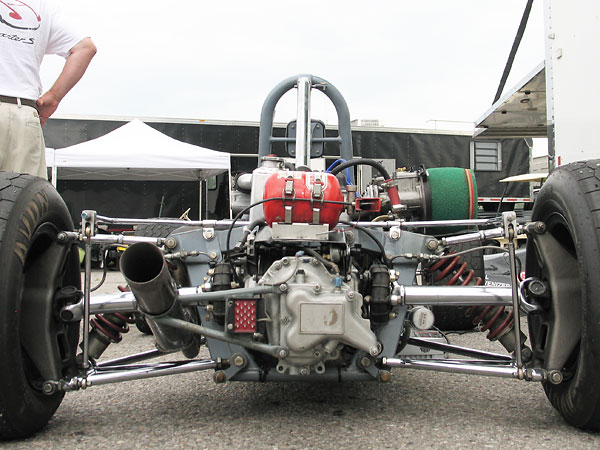
�
Titan Mk3 rear suspension: coilover shocks, inverted lower wishbones, single top links, and twin radius arms.
�
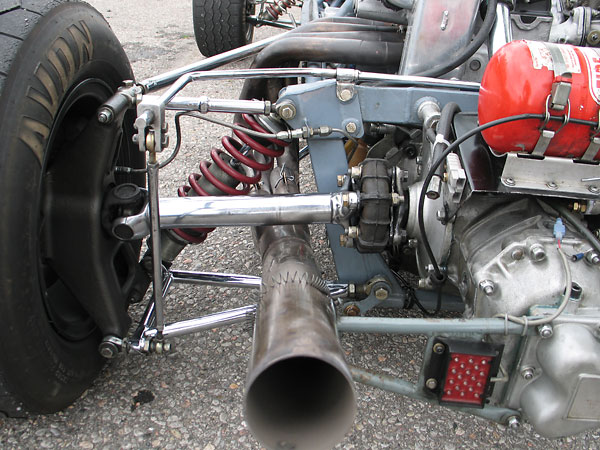
�
Exhaust packaging. Note LED rain light at bottom right.
�
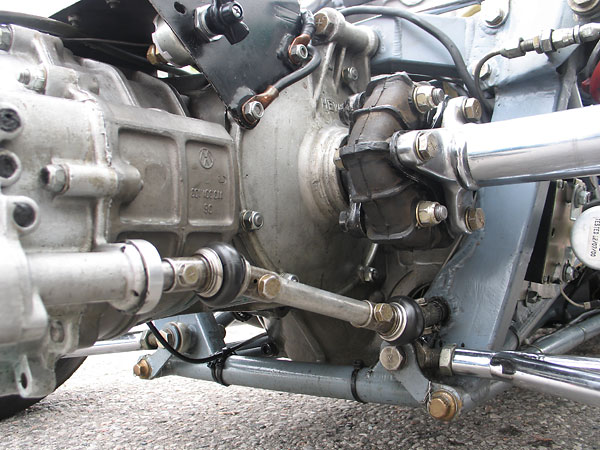
�
The shifter linkage has been upgraded with Apex universal joints with Neoprene lubrication covers.
�
Note Lucas battery disconnect switch at top of photo.
�
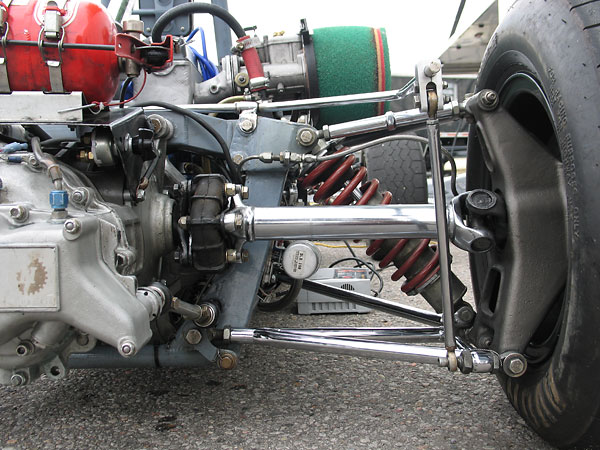
�
Rotoflex drive couplings.
�
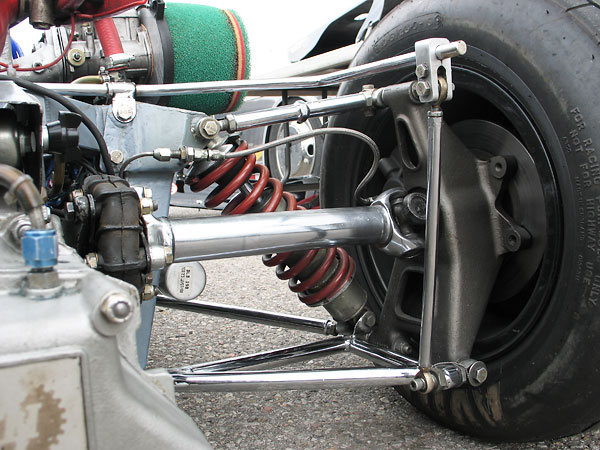
�
Titan proprietary magnesium uprights.
�
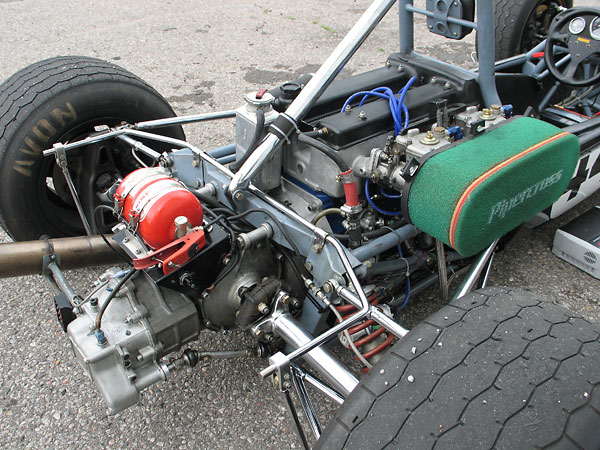
�
Adjustable rear anti-sway bar.
�
�
Interior
��
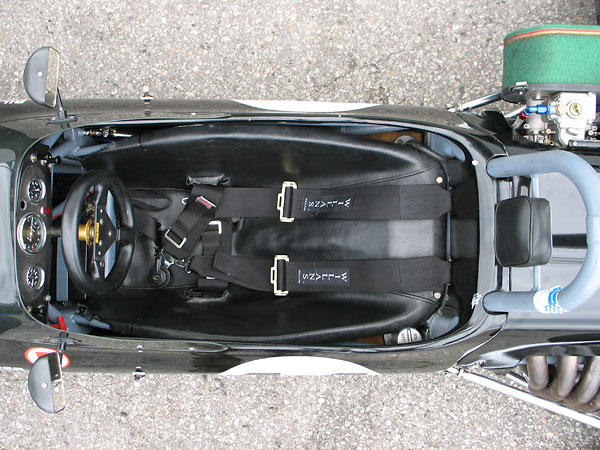
�
Vinyl covered fiberglass racing seat. Willans six point cam-lock safety harness.
�
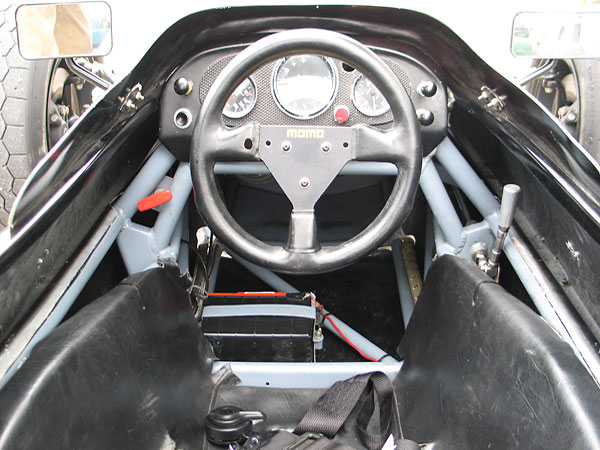
�
Momo ergonomic steering wheel.
�
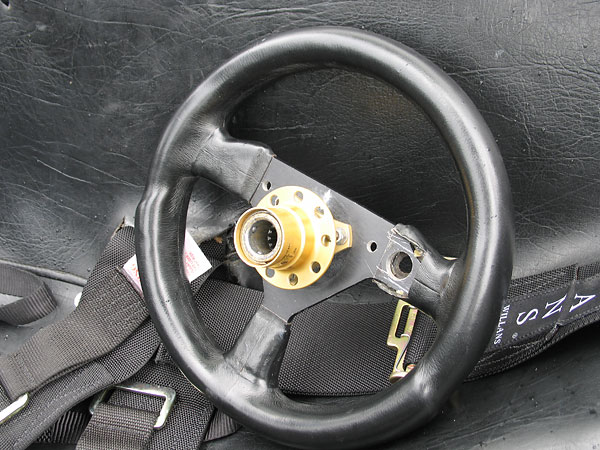
�
This Lifeline quick release steering wheel hub is an important safety feature.
�
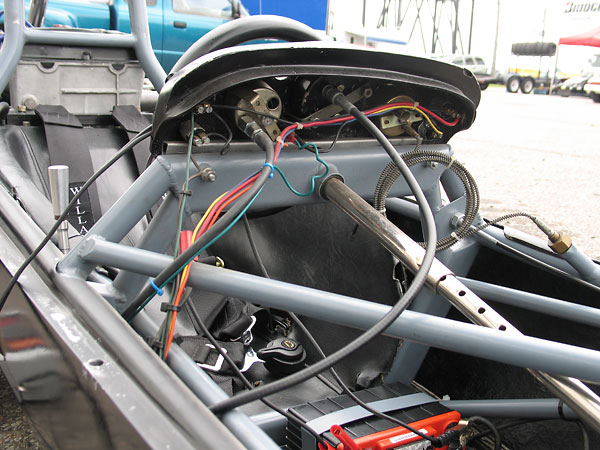
�
The steering shaft telescopes to suit the driver's comfort.
�
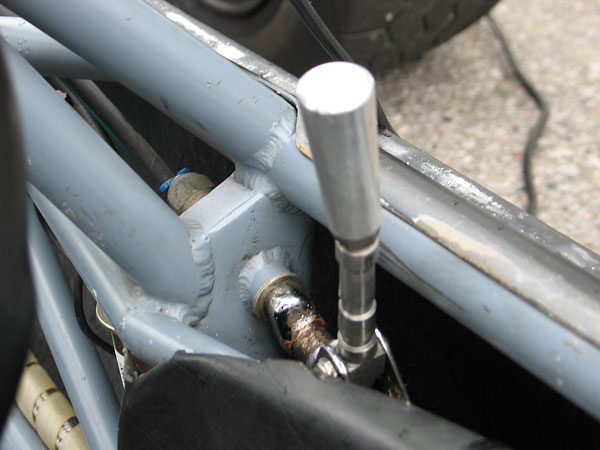
�
Gear selector.
�
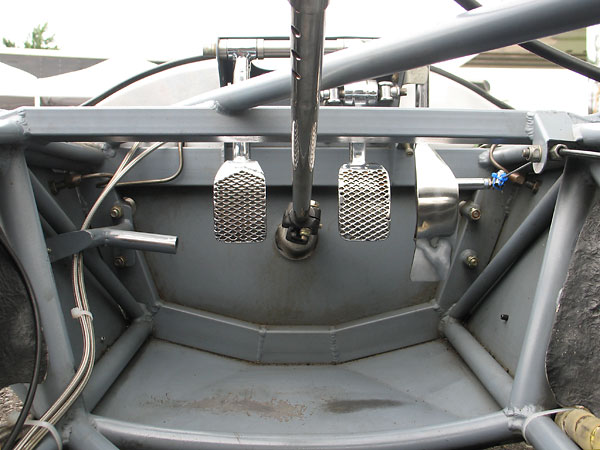
�
Steel panels reinforce the footbox area.
�
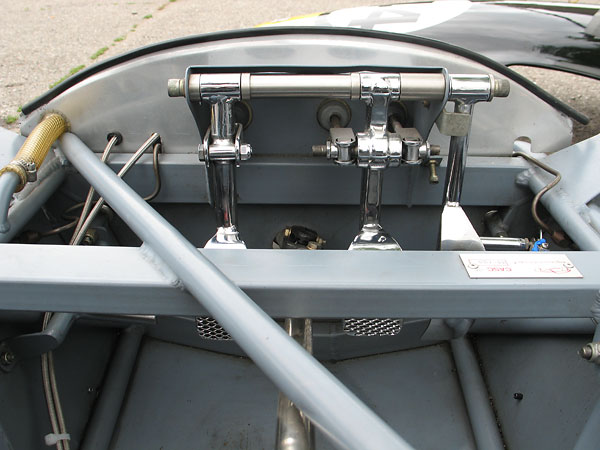
�
Brake bias may be adjusted by rotating a threaded shaft connecting the two brake master cylinders.
�
As the shaft turns, a spherical bearing within the pedal is shifted to one side or the other.
�
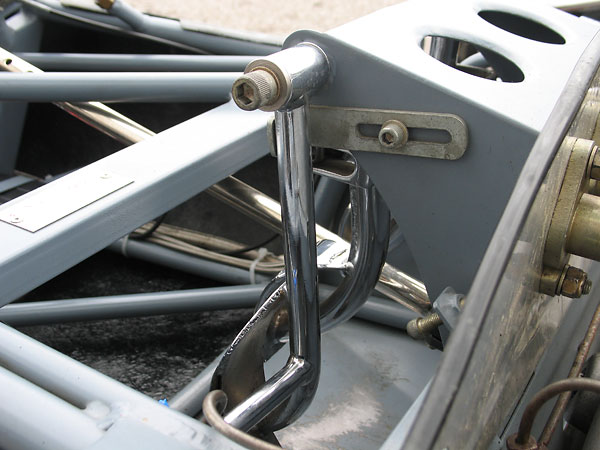
�
Adjustable positive stops have been installed at both ends of the throttle pedal's travel.
�
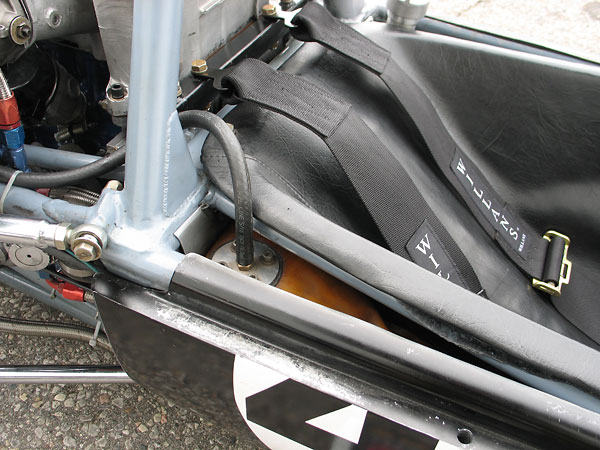
�
Wedge-shaped under-seat fuel cell.
�
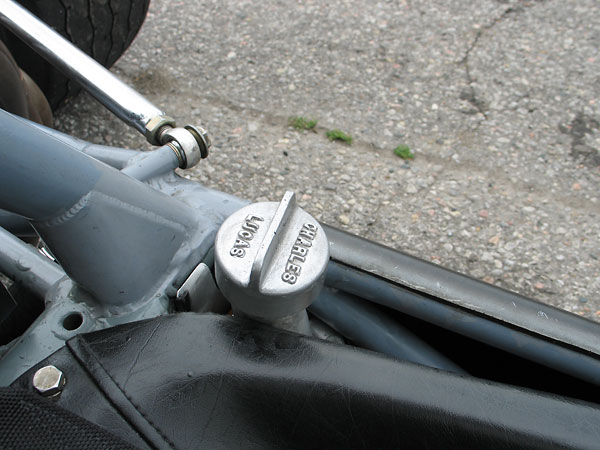
�
Charles Lucas cast aluminum fuel filler cap.
�
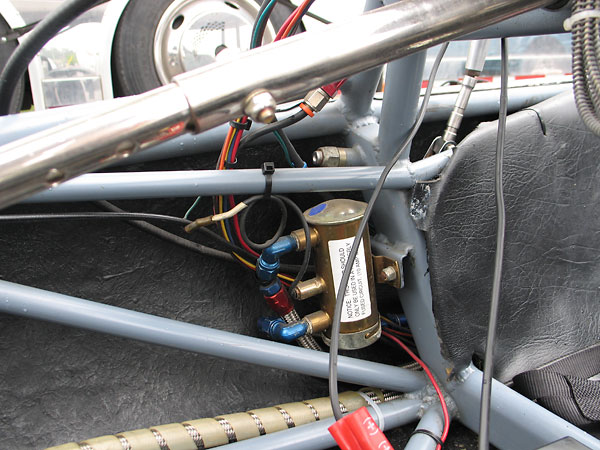
�
Facet (Bendix type) electric fuel pump.
�
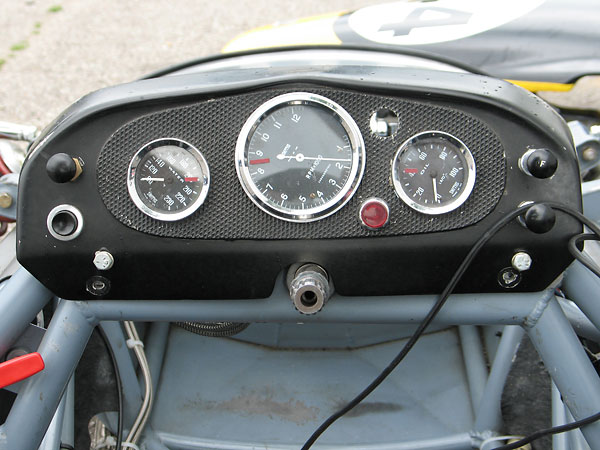
�
Smiths coolant temperature gauge, chronometric tachometer, and oil pressure gauge.
�
�
Exterior
��
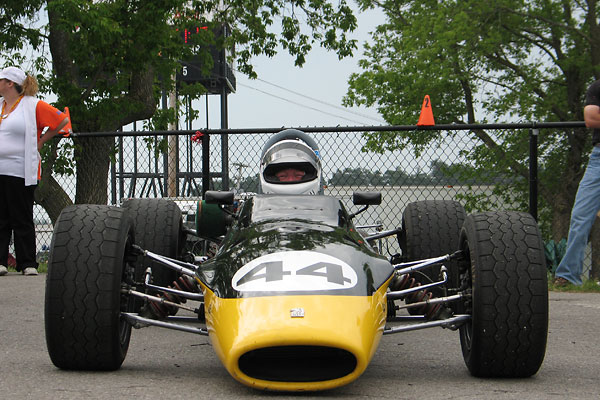
�
We enjoyed watching Bill compete in VARAC's 31st International Vintage Festival at
�
Mosport International Raceway on June 20, 2010. He lapped the challenging 2.458
�
mile circuit at 1:45.218 for an average speed around the circuit of 82.63mph.
�
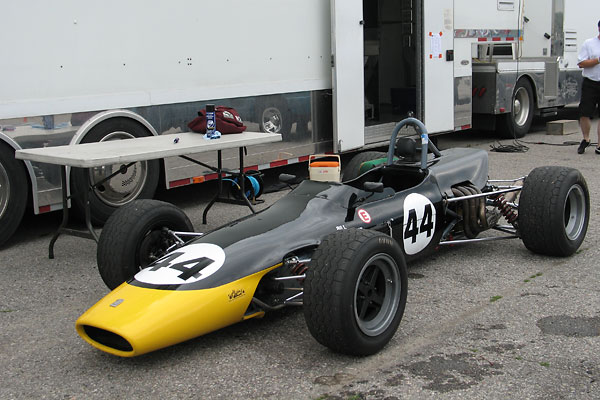
�
The Mk3 was Titan's first model, and Bill's Mk3 is car number six of only seventeen built.
�
The Titan Registry is aware of ten surviving Mk3 racecars: two in Scandinavia, three
�
in Canada, and five in the United States of America.
�
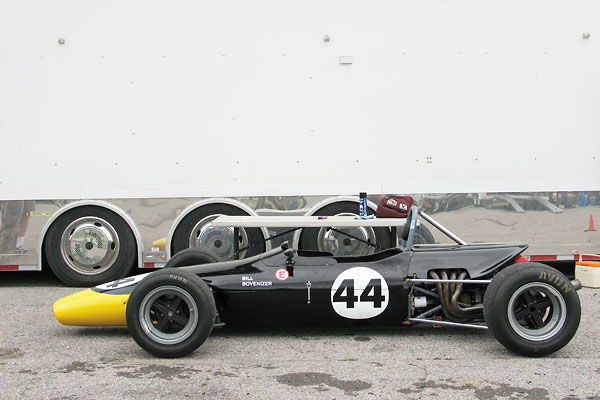
�
In nine years of production, Titan produced a total of 400 cars (give or take just a handful).
�
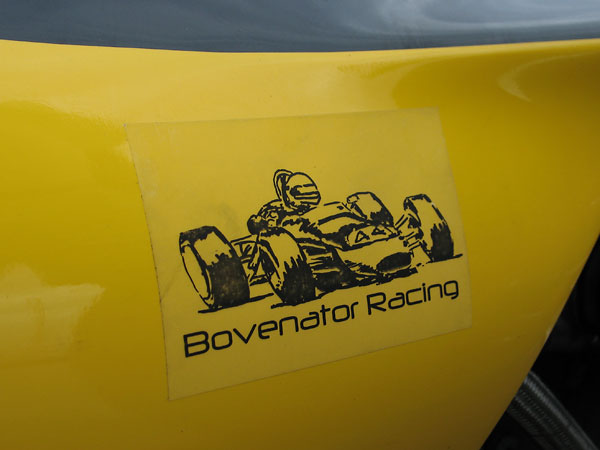
�
Bovenator Racing.
�
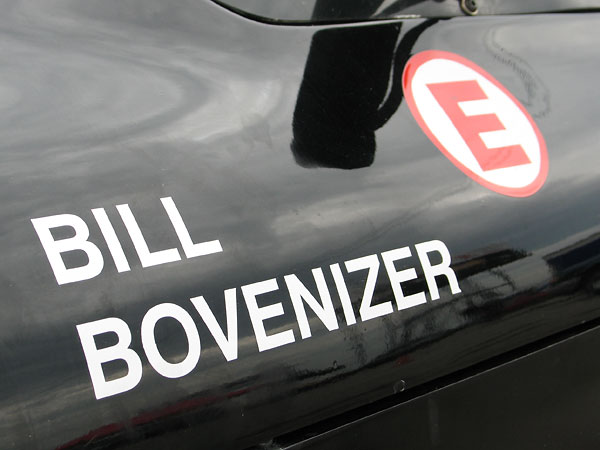
�
When Bill Bovenizer purchased a Lotus 51 Formula Ford from Sportscars Unlimited in 1968,
�
he became the first Formula Ford owner in Canada and possibly in all of North America.
�
Bill raced open-wheel racecars for about a decade before taking a break. He returned
�
to racing with the purchase of his Titan MkIII Formula B vintage racecar.
�
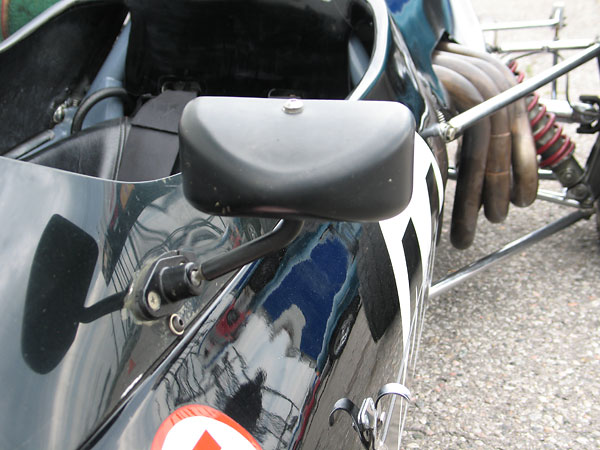
�
Bill still owns the period-correct mirrors that came with his Titan.
�
He has found these SPA "F1" mirrors provide a much clearer view.
�
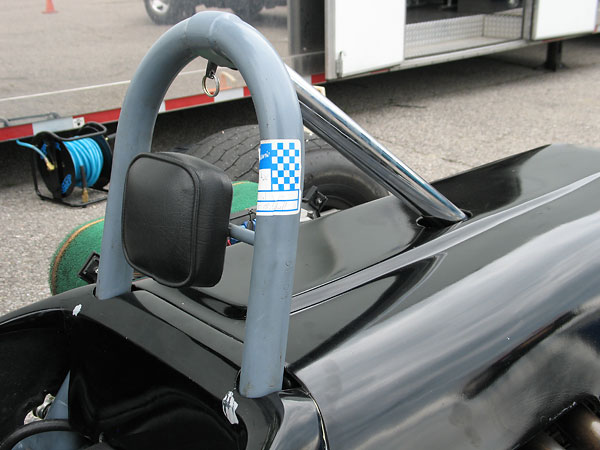
�
Roll hoop and headrest.
�
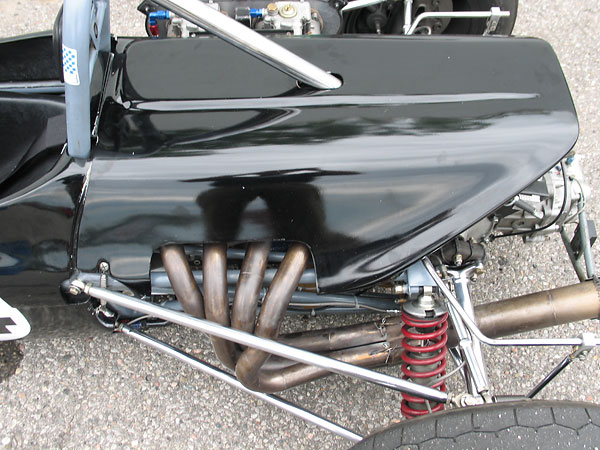
�
Engine cover, left side view.
�
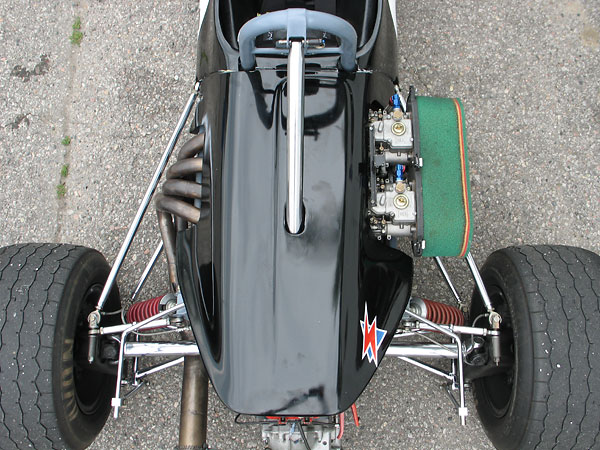
�
Engine cover, top view.
�
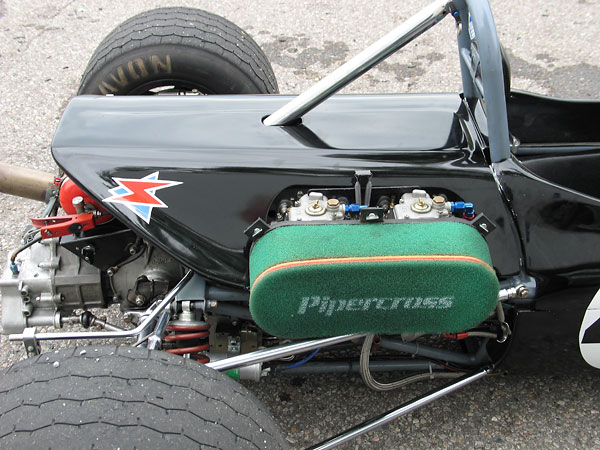
�
Engine cover, right side view. The sticker points to a Lucas battery disconnect switch.
�
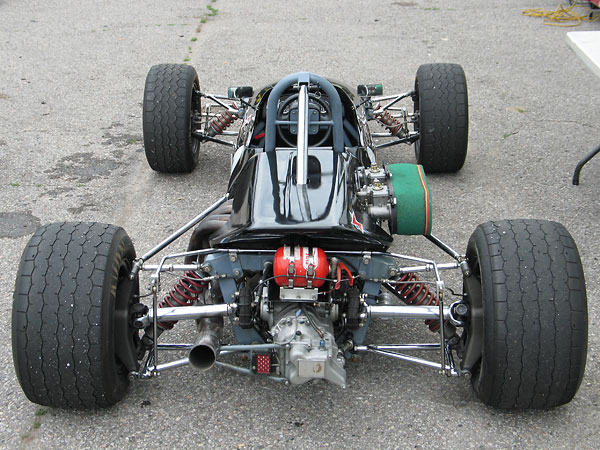
�
Titan sourced its frames from Arch Motors and its fiberglass bodywork from Specialised Mouldings.
�
Both were located in Huntingdon, and in the late sixties they were key suppliers to much of the
�
British racecar industry. Titan's principal rivals used Arch Motors and Specialised Mouldings too.
�
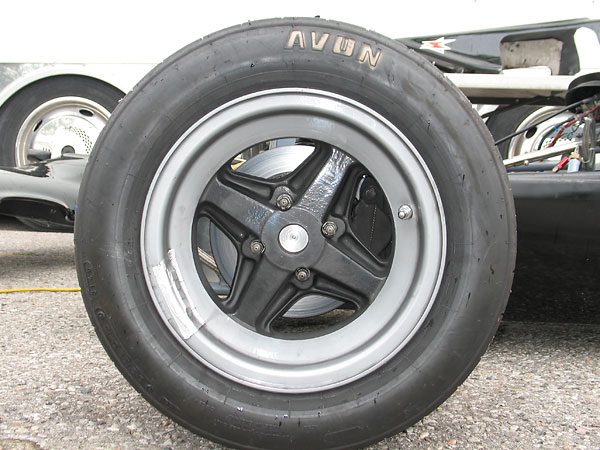
�
Brabham style 4-spoke magnesium wheels. (Bill has a set of much rarer Titan mags too.)
�
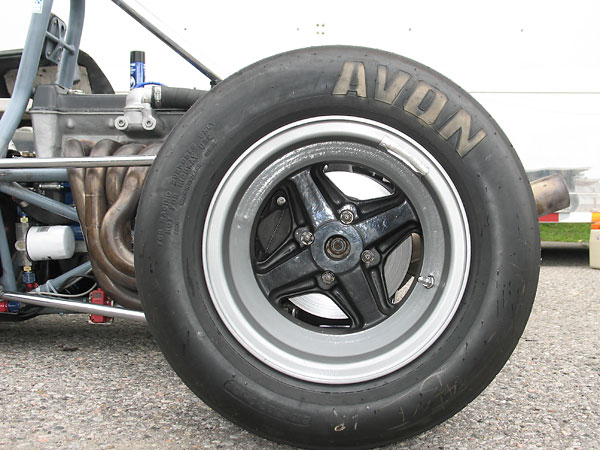
�
Avon racing tires (8.2/22.0/13 front and 10.5/23.0/13 rear).
�
�
All photos shown here are from June 2010 when we viewed the car at VARAC's 31st International Vintage Festival�
at Mosport International Raceway, near Toronto Ontario. Photos by Curtis Jacobson for BritishRaceCar.com, �
copyright 2011. All rights reserved.
�
| If you liked this article, you'll probably also enjoy these: | �|||||
 | �
Al Murray '67 Brabham BT21 | �
 | �
Howard Freeman '68 Merlyn 11 | �
 | �
Andy Antipas '73 Titan Mk6 | �
| You're invited to discuss anything you've seen here on The British Racecar Motorsports Forum! | �|||||
�
Notice: all the articles and almost all the photos on BritishRacecar.com are by Curtis Jacobson.
�
(Photos that aren't by Curtis are explicitly credited.) Reproduction without prior written permission is prohibited.
�
Contact us to purchase images or reproduction permission. Higher resolution images are optionally available.
�

 �
�